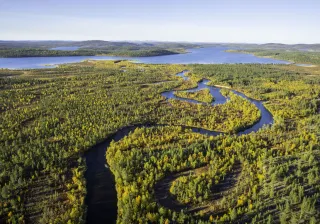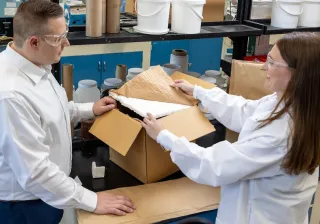Finland has the highest amount of biomass per capita in Europe. VTT and Aalto University's FinnCERES joint competence centre for the materials bioeconomy is seeking solutions for using this biomass in new, and even surprising, products. Such products may even double the value of forest industry production by 2030.
Cooperation between VTT and Aalto University on the bioeconomy is already well established, but FinnCERES, a bioeconomy materials competence centre, is combining the university and research institute's resources in a new way.
– We are combining resources on this scale for the first time. Cooperation will rise to a new level, says Professor Orlando Rojas of Aalto University's School of Chemical Engineering.
He is heading the FinnCERES competence centre on behalf of Aalto, while Research Professor Kristiina Kruus does so for VTT.
The centre has been awarded Academy of Finland funding as a flagship project, which is expected to last eight years. Decided on last spring, EUR 9.5 million of funding paid via a new financial instrument will cover the first four years of the project. Funding for the second four-year period will be based on an interim evaluation of the results of the first half.
The total project funding is EUR 24 million. Although dozens of researchers from Aalto and VTT participated in drafting the project plan, industry representatives were already involved in the preparatory phase.
– We closely monitor the needs of industry. We need to cover the entire path from science to product, says Kruus.
The flagship project's criteria include societal impact, in addition to the scientific impact and objectives.
– The flagship project is important to the entire Finnish economy. It involves seeking future solutions for forest industry products. This subject is also of relevance to other countries: Sweden and Canada are investing heavily in the area. It is important that Finland is in the game, says Rojas.
New added value from pulp-based products
The forest industry is the largest export sector in Finland. It has been criticised for being overly based on exporting low-value-added products, such as pulp.
– FinnCERES is developing higher value-added products based on our raw materials. The time is ripe for new solutions. Our waters are being polluted by microplastics: we can make biodegradable packaging materials from lignocellulose, says Kruus.
Lignocellulose is a renewable natural resource. Its superior qualities include its strength, formability, and chemical and thermal stability. Above all, as a biodegradable material it is consistent with sustainable development.
Includes surprising applications
This plant-based biomaterial is regarded as the 'plastic of the future' for packaging, textiles and filters, but it also has futuristic applications. The use of cellulose is being studied within optoelectronics and nanoelectronics, and as a suitable material for energy storage and semi-conductors.
–The replacement of plastics has been highlighted, but we are doing more. We have ideas for using nanocellulose to remove harmful substances, such as hormones and carcinogens, from air and water. To catch these 'big fish', we need to invest in the basics first, says Kruus.
She states that new biocomposite products will soon enter the market, whereas optoelectronic and nanoelectronic applications will take over five years to do so.
– These fascinating products have a great future.
Optoelectronic applications are based on the fact that nanocellulose refracts light in a unique way. There are multiple applications for this property, such as paints and coatings.
A biodegradable smart wristband?
Kruus refers to wearable electronics as an example of nanoelectronics applications.
– Smart wristbands used for measuring sports performance tend to have a short lifecycle. It would be advantageous if their material were recyclable and biodegradable. The idea would be to replace oil-based semiconductors with cellulose, she says.
Professor Rojas also says that the competence centre is seeking both smaller volumes with high added value, and large volumes with lower value added.
– The flagship project is a thinktank for the entire materials bioeconomy. It is a driver of knowledge and a catalyst for other research, but the overall issue is broader. We believe that we can grow Finnish research in the field by one and a half times in eight years, says Rojas.
As part of the FinnCERES ecosystem, the flagship project provides basic information that can be used by spin offs and existing companies in the industry cluster. Rojas mentions food and IT sector companies, in addition to the forest industry's involvement.
– The project will focus on basic information in the early stages, the impact will grow over time. We are creating a new model for interaction in Finland between universities, research institutes and companies. This is a fascinating project at Northern European level, he says.
The interim review will evaluate the success of the flagship project based on the number of scientific publications, inventions, breakthroughs and new enterprises.
– We promise to train students and researchers to meet the future needs of industry. We produce not only expertise, but also skilled researchers, Rojas points out.
New products require new technologies
The competence centre focuses on entire technologies in addition to new products. The major challenge for wood materials is the separation of pulp and lignin.
– This is business as usual for the pulp industry, but the process has been optimised to achieve a certain grade of fibre. In the future, all three main lignocellulose polymers – lignin, hemiscellulose and cellulose – will need to be separated into a usable form from the viewpoint of further processing, says Kruus.
Typical uses of cellulose include as a fibre in paper and packing cardboard. Similarly, long and adaptable hemiscellulose chains produced from sugar units provide a chemically more versatile polymer, which could be used in thickening agents, packaging foils and emulsifiers.
From research results to commercial products
The cooperation agreement on the establishment of the FinnCERES ecosystem, signed by VTT and Aalto University in late August, is also aimed at boosting the commercial exploitation of the project's results.
– We are interested in developing our results all the way into products, for the benefit of industry and Finnish society. This will also involve international cooperation. Because we want to avoid geographic restrictions, not all the companies involved will necessarily be Finnish. A company that is Finnish today, may change nationality tomorrow, says Kruus.
FinnCERES is supporting the implementation of Finland's national bioeconomy strategy, which has the objective of creating 100,000 new jobs in the country and increasing turnover by EUR 40 billion by 2025.





